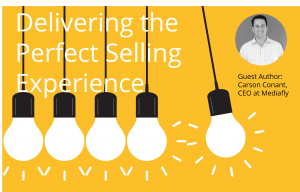The State of Sales and Marketing Alignment in Investment Management

It is universally understood in the marketing community that sales and marketing alignment is crucial to hitting revenue goals. Alignment around shared goals, technologies and processes allows you to monitor and optimize every stage of the buying cycle. Reports like this one from Marketing Advisory Network suggest that sales and marketing misalignment is not just a buzzword: companies are truly struggling with this reality.
But how aligned are sales and marketing teams at investment management firms, specifically?
We were curious.
We hosted a private Marketing Roundtable discussion with sales and marketing leaders from top investment management firms. We wanted to learn more about the state of sales and marketing alignment at investment management firms. Here are a few notable takeaways we’d like to share:
Takeaway 1: The most heavily aligned firms are using Sales Training and Business Intelligence to close the gap
During the roundtable discussion, many marketers expressed a desire for more alignment. Sales is often blocking their access to CRM and limiting their visibility into the customer lifecycle. A few participants described their marketing and sales organizations as a “partnership”, though. And, that’s a signal that things may be changing. These participants mentioned that their firms are making strides toward treating marketing as a strategic partner, rather than an order-taker. This sparked a conversation about how the move toward a partnership mentality is highly dependent on how leadership sets the vision at the firm. As long as leadership prioritizes the value of sales and marketing alignment, there is a real opportunity to bridge any gaps and improve results. The firms who are making the most process with alignment are focusing on a couple of key areas:
1. Sales Training
One firm mentioned implementing regular sales training sessions focusing on using centralized messaging around products and thought leadership. As part of these training sessions, they require salespeople to practice in front of their peers and get graded on performance. Participants from this firm mentioned that this was a big turning point for them in terms of quality control and delivering a consistent story.
This same firm also mentioned that marketing plays a significant role in their annual, national sales meeting. In this meeting, they have the opportunity to present marketing goals and how they align with Sales. Not all firms had similar programs in place, but many participants at the table agreed that programs like these are a strong move toward marketing and sales alignment and should be seen as a best practice.
The Marketing Advisory Report (mentioned above) shows that communication variety is the key to success — not volume. In other words, it is the variety of training techniques and communications that make a difference. It’s not the volume of meetings between marketing and sales. The report states that marketers who exceeded revenue goals were 3.5X as likely as those who missed their goals to use email, virtual and in-person training, and a sales tool repository to communicate with Sales.
2. Business Intelligence
A few firms mentioned the ability to analyze data via a Business Intelligence team has been a big step forward. One participant said the BI team has given their marketing team a seat at the strategy table. “When we look at how closely aligned our sales and marketing organizations are, they’re very closely aligned today. The priority is basically set by the data we’re pulling in from a marketing perspective. In the past, sales was driving the marketing effort. Now, it seems to have shifted because we’re pulling all this data in. We can say to sales, ‘The activity was for this specific firm at this specific point in time. Let us help. Work with us to set up the goals'”, they said. I believe more firms will come to embrace as a way to align teams and make smarter business decisions.
Takeaway 2: Teams are more aligned when investment marketers use data to deliver the highest value sales leads
One major alignment challenge cited by the roundtable participants was around the topic of sales productivity. If a major benefit of alignment is shorter sales cycles and higher close rates, the teams must work together to determine a) the highest value sales opportunities and b) how to nurture those leads through the sales process. Although the mindset is seemingly shifting to sales and marketing working together as one unit, the big challenge is aligning around the goals and metrics that drive decision-making.
The Head of Strategy and Business Analytics for a large, global investment management firm said, “The big question in my mind, as I work with our marketing group is, is [do we focus on] current clients? Is it that big long tail? Or it is somewhere in between?”
Several firms reported using Business Intelligence teams to pull together data that could inform decision-making on who sales and marketing teams should pursue, and how. The Global Head of Marketing Services for a major global asset manager commented that BI has become integral to their strategy. “Over the past few years we’ve really been focusing on digital outreach. This way, you don’t have a client-advisor assigned to prospects, so to speak. You rely on your digital outreach technology to pull lead information in. Once you’ve received that data, it goes through a process within our BI team to assign leads into buckets. Then, Sales will follow up when they reach a certain threshold.”
In other words, the most effective marketers are using data to inform their sales enablement strategies. They are working with their BI teams to assign lead scores and pass-off the highest potential leads to the sales team. Leads with lower scores can be nurtured by marketing until they are sales-ready.
Takeaway 3: Investment Marketers that can measure attribution (ROI) have better relationships with Sales
A big eye-opener for many of the executives in the room was just how much untapped potential there is in terms of leveraging existing technology to create a clear picture of the buyer’s journey, optimize close rates, and measure ROI.
Most firms are struggling to integrate CRM, marketing automation, presentation and content management tools, and email platforms in an effective manner. This, of course, is essential for understanding the buyer’s journey. Salespeople and marketers need insight to both properly nurture prospects through the sales funnel and measure attribution.
A Director of Corporate Services for a global asset manager said, “We have so many touchpoints between SalesForce automation, wholesaler visits, mailings, emails, visitors to the website, people registering on the website, people calling into the call centers; we have a horrible time tracking ROI. We get into arguments with sales and marketing and national accounts. Was it the marketing campaign? The wholesalers’ phone call? Or was it the website visit? We have all this data, but no way to clearly attribute it.”
For all firms, especially the larger ones, connecting all of the data is the big challenge. This is where the BI function has proven to be very beneficial for a couple of the firms. One participant utilizing a small BI team said, “It’s a centralized point that all of the data feeds into. It’s also a relatively impartial third party. It [informs] the wholesaler who thinks [the sale] is because of their phone calls, but it may have actually been a result of a series of emails, visits to the website, a webcast that they went to, a[conversation] with a portfolio manager, and our thought leadership.”
Firms that have invested in integrating marketing and sales technology platforms and centralizing business intelligence are finding the most success around measuring effectiveness, which goes a long way toward aligning sales and marketing. One participant noted, “We’re finally starting to see that you have to go and buy some [technology]. You can’t just have people creating more stuff. You have to actually make the investment.”
Learn how to drive sales through a compliant, automated process.
Here are some related resources that might interest you:
 From the Blog: Five Key Aspects of a Great Pitchbook Automation Software Tool |  From the Blog: Deliver the Perfect Selling Experience |  From the Blog: How to Prep your Team for Content Automation |





 Compare the Top 3 Finserv Content Automation Vendors [White paper]
Compare the Top 3 Finserv Content Automation Vendors [White paper] Create Pitchbooks the Drive Sales [White paper]
Create Pitchbooks the Drive Sales [White paper] Build vs. Buy: Should Your Financial Services Firm Outsource or Insource Marketing Technology? [White paper]
Build vs. Buy: Should Your Financial Services Firm Outsource or Insource Marketing Technology? [White paper]  10 Tips for Rebranding your Fund Marketing Documents [White paper]
10 Tips for Rebranding your Fund Marketing Documents [White paper]




